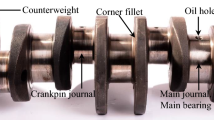Conclusions
-
1.
The use of high-alloy 18KhNVA steel for manufacturing crankshafts is not advisable:
-
a)
the high sensitivity of high-strength steel to stress concentration means frequent fatigue rupture during operation;
-
b)
reduction in the strength of the shaft metal through increase in residual austenite cannot be recommended since it involves a reduction in the stability of the shaft (heating during grinding or cooling below 0° may cause the austenite to change into martensite and warp the shaft).
-
2.
The manufacture of engine crankshafts from loweralloyed steels would bring about a considerable saving in alloying elements and improve the machinability of the parts. A sorbite structure is best for parts working under cyclic stress.
Similar content being viewed by others
Additional information
Research registered in Invention and Discovery Committee attached to Council of Ministers of USSR, No. 16914, January 3, 1960. (First registration).
Rights and permissions
About this article
Cite this article
Zelenskaya, G.I., Norova, L.I. & Yurgenson, A.A. Material for making and heat treating crankshafts for high-speed diesel engines. Met Sci Heat Treat 4, 171–172 (1962). https://doi.org/10.1007/BF00816377
Issue Date:
DOI: https://doi.org/10.1007/BF00816377




